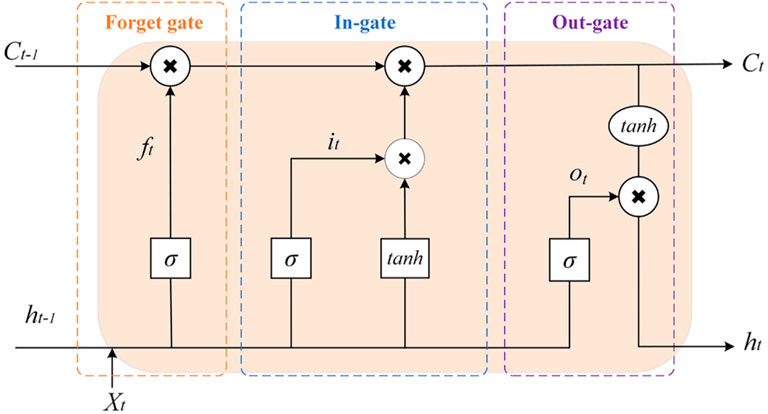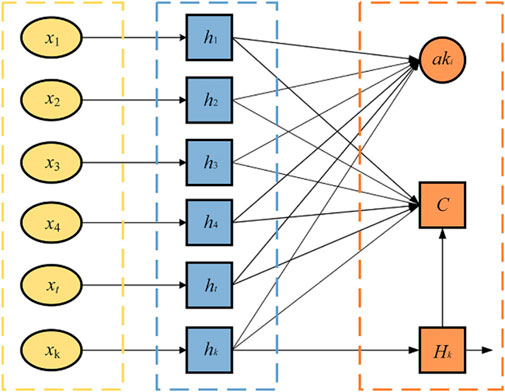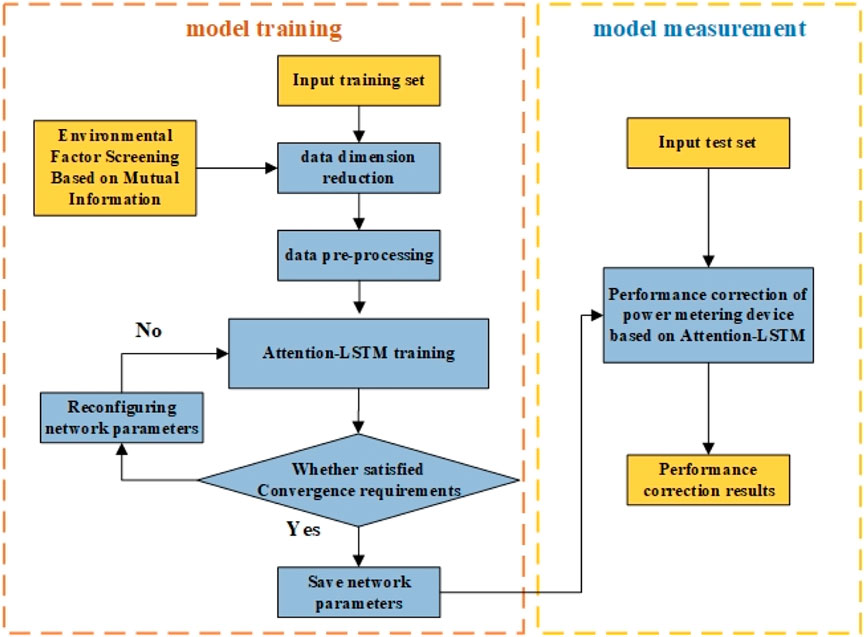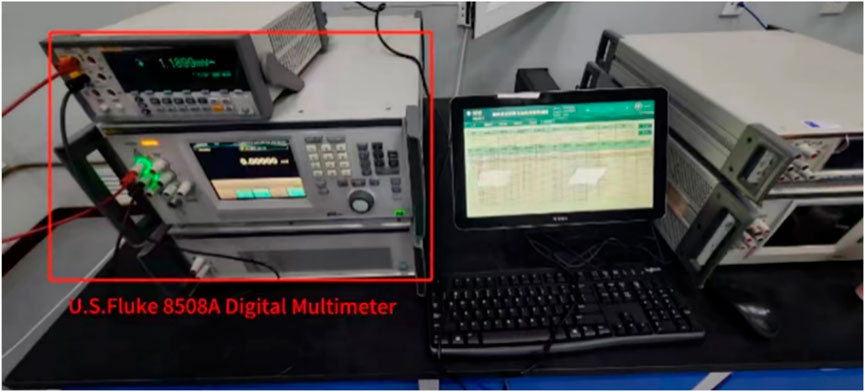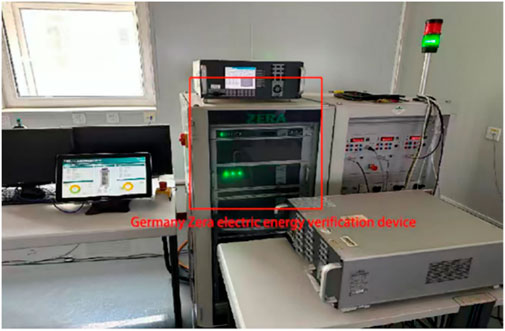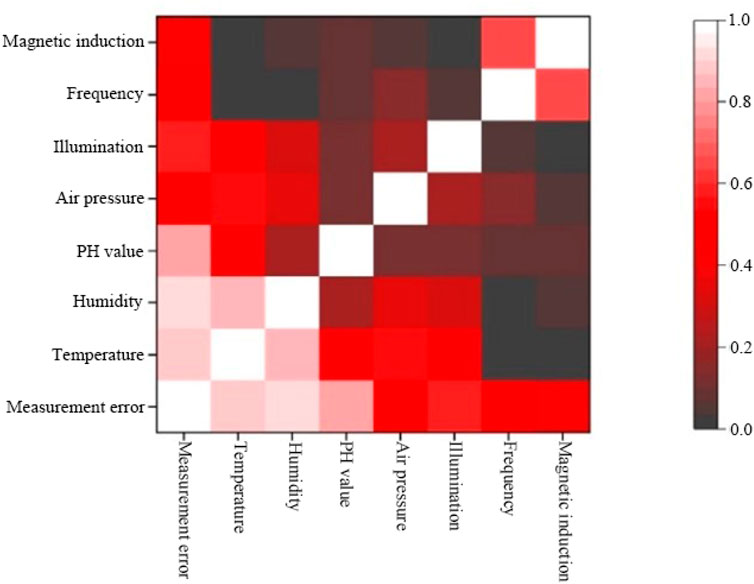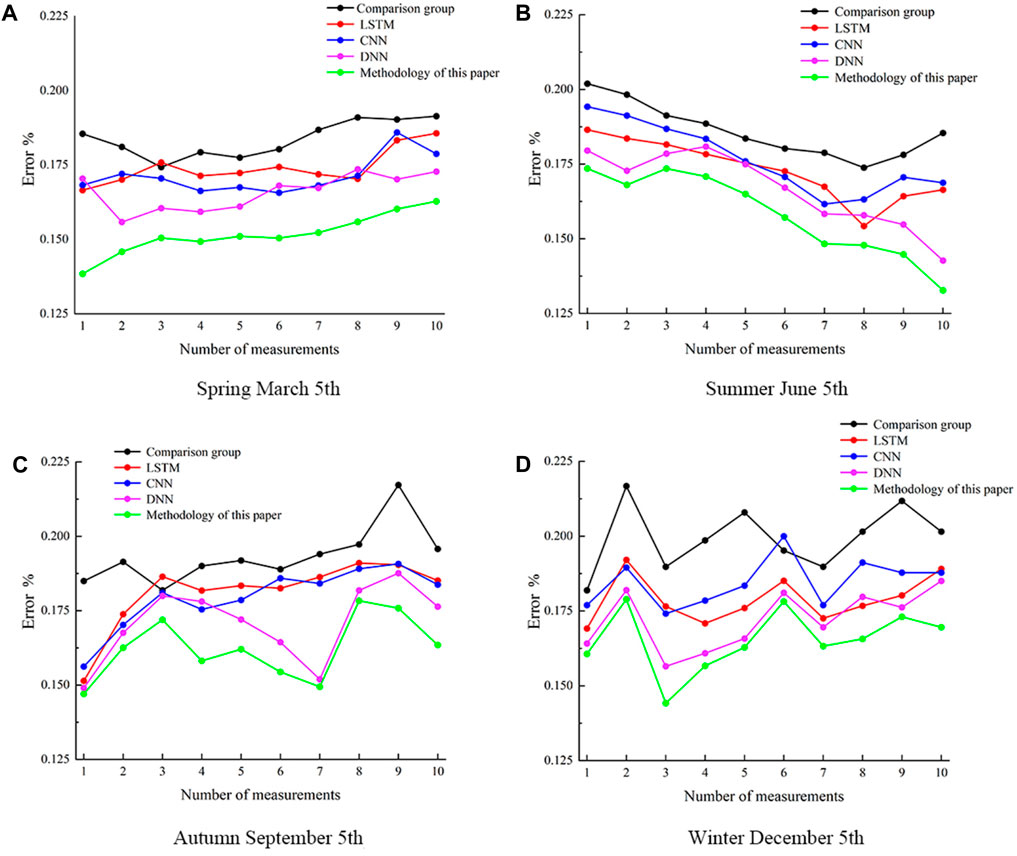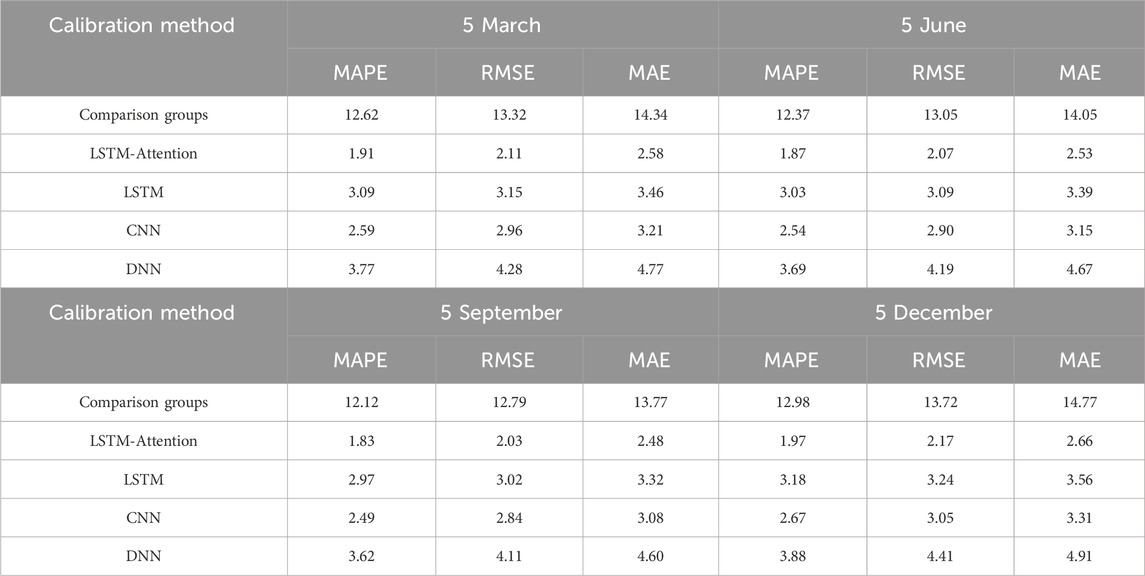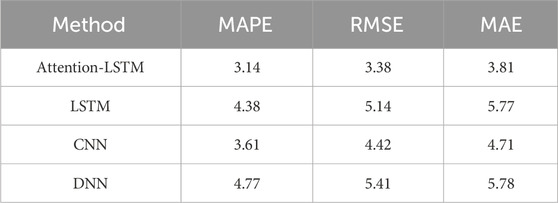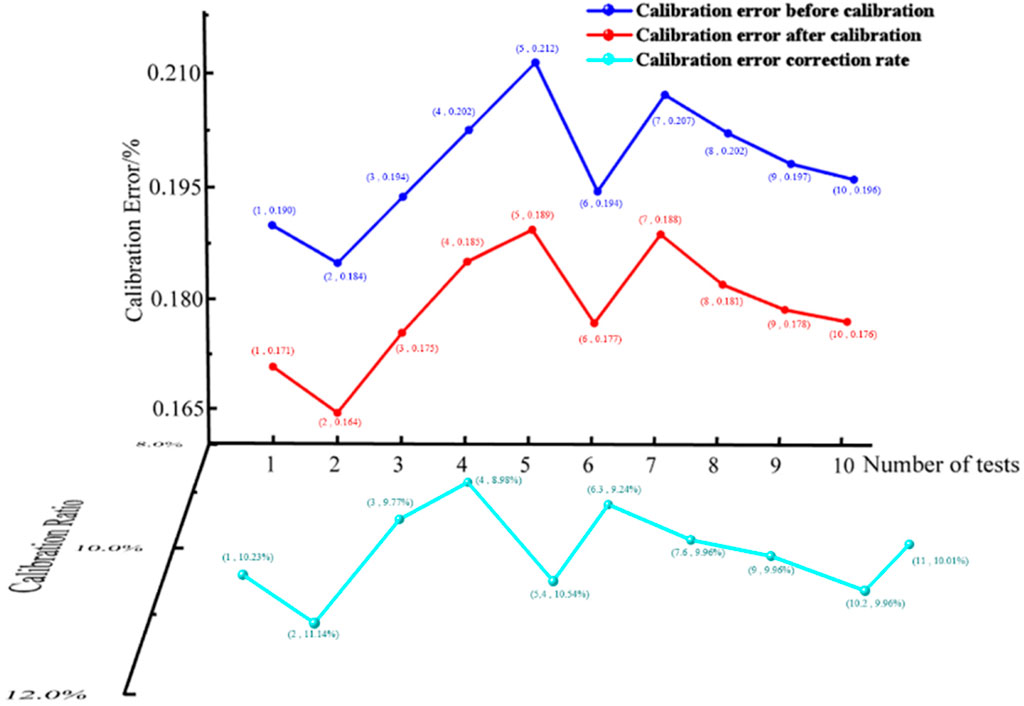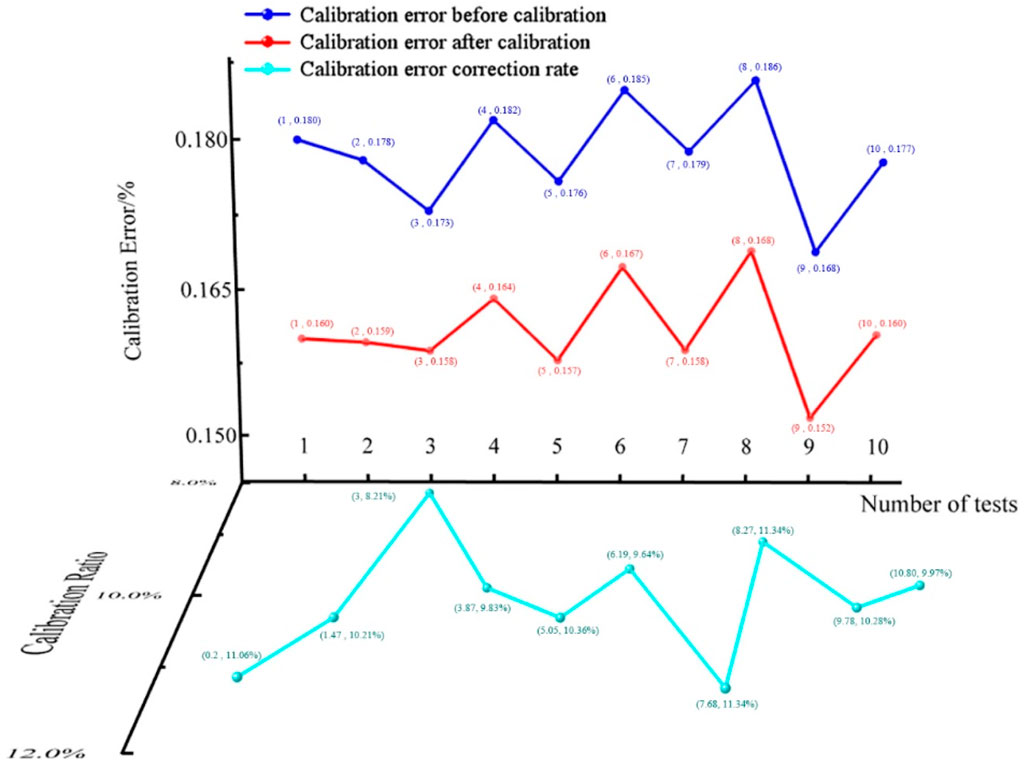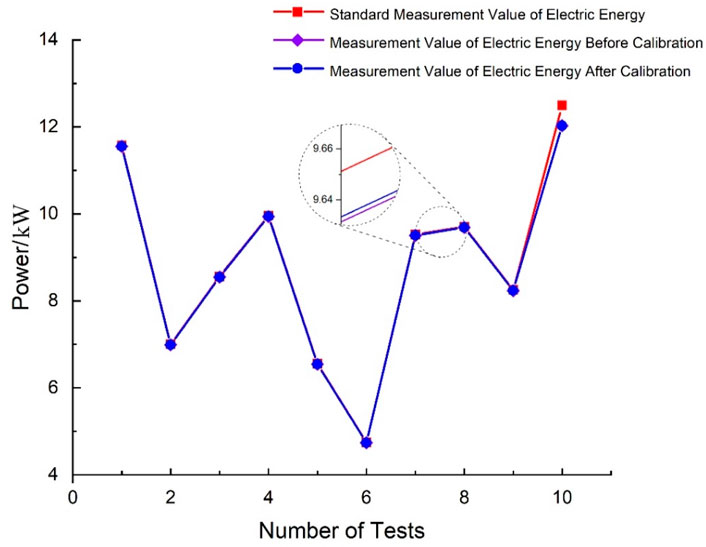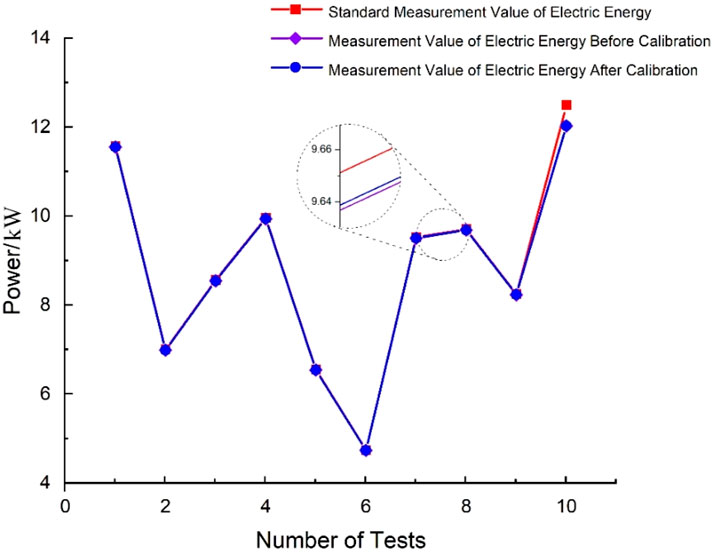- 1Beijing Electric Power Science and Smart Chip Technology Company Limited, Beijing, China
- 2Beijing Smart-Chip Microelectronics Techno1ogy Co., Ltd., Beijing, China
The operating environment greatly influences the accuracy of power metering devices, resulting in variations and inconsistencies in measurement results across different working situations. A calibration model for power metering devices is proposed in this study, considering a range of environmental circumstances. The first step involves investigating the environmental conditions that impact the accuracy of power metering devices. The mutual information approach is utilized to identify environmental disturbances affecting device accuracy. A machine learning-driven symmetry attention Long Short-Term Memory (LSTM) network addresses measurement errors, capitalizing on the network’s symmetry data knowledge. Ultimately, the efficacy of the suggested approach is substantiated through the utilization of performance indicators, namely, Mean Absolute Percentage Error (MAPE), Root Mean Square Error (RMSE), and Mean Absolute Error (MAE). The results show that the proposed method can effectively reduce the errors of the power measurement device in all quarters, and the error reduction effect is over 10% in the spring, which is better than other models, demonstrating exemplary performance in correcting the calibration errors of the power measurement device.
1 Introduction
In the study of modern electric power systems, the accuracy and reliability of electric power metering equipment are considered crucial for ensuring the safety and stability of the power grid and the fairness of electricity transactions. Recent research has made progress in enhancing the performance of these devices, especially in the development of error analysis and prediction methods. However, these traditional methods have shown limitations in handling the complexity of large-scale electric power data. Introducing machine learning techniques offers a new perspective for the error diagnosis and correction of electric power metering data. However, how to effectively apply these techniques for error correction under complex electric power system conditions remains a question that needs to be fully answered. This study introduces advanced deep learning technologies to propose an innovative method for predicting and correcting electric power metering errors to address and solve this challenge more accurately.
Intelligent power systems continuously generate a vast amount of electrical data during operation. Electrical metering equipment to measure these data is critical to ensuring the safety and stability of the power grid (Xu et al., 2021). emphasizes the application value of expert systems in fault detection through their research on fault diagnostic methods for electric energy metering equipment, providing an efficient fault diagnostic framework for electrical metering devices. In recent times, governments worldwide have placed a high emphasis on the implementation of electric power metering and data analysis, which has resulted in allocating substantial human, financial, and material resources to collect, research, analyze, and utilize electric power metering data, thereby facilitating the development of the national electricity metering industry.
As specialized instruments within intelligent power systems, the accuracy and reliability of data produced by electrical metering devices significantly impact power transactions, directly affecting the fairness and justice among stakeholders in the power sector. Literature (Sun et al., 2022) demonstrates the potential of artificial intelligence technologies to enhance the accuracy of electric energy metering by exploring the state detection of metering devices using computer neural networks. In recent years, many researchers and experts have investigated the measurement error issues of electrical metering devices. What’s more, Literature (Li et al., 2018) analyzes the wiring error problem of electric energy metering equipment. It proposes a correction technique based on voltage and current measurement parameters, significantly reducing measurement errors caused by wiring errors. Furthermore, Literature (Ma et al., 2021) proposes an error prediction method for predicting electricity metering errors considering extreme environmental conditions and compares it with several advanced forecasting techniques. The results show that the proposed method has superior outlier detection and error prediction capabilities, even with a limited sample size. Furthermore, Literature (Zhang F. et al., 2023) tackles efficiency, safety, compatibility, and accuracy challenges in high-voltage electric energy metering equipment verification methods. It proposes a remote verification system design based on the electric power cloud platform. It demonstrates comprehensive error accuracy within 0.02 during test applications, meeting the high precision requirements for remote calibration of large high-voltage metering devices. Similarly, Literature (Zhou et al., 2016) also focused on the randomness of measurement error changes in electrical metering devices caused by various factors, proposing an improved dynamic time warping (MDTW) algorithm and designing a novel hybrid semi-trapezoidal Monte Carlo generator. The effectiveness of this method was verified using field test data from electric energy metering devices at a 110 kV substation. While much of the literature discussed has addressed the measurement errors of electric power metering devices, some approaches rely on manually defined rules or calculations based on physical models. However, these methods need assistance when dealing with the large datasets generated by electrical metering devices, as data complexity and diversity increase, leading to increased computational inaccuracies.
As technology for big data has advanced, machine learning has become a prominent tool in correcting errors in power metering devices. Literature (Zhang et al., 2020a) introduces a method based on beetle swarm optimization (BSO) for backward propagation neural networks (BPNN) to address challenges such as omissions, false alarms, and low manual judgment accuracy. This method provides a method for developing anomaly diagnosis models for electricity meters. This model significantly improved error prediction performance and the accuracy of diagnosing instrument anomalies. Similarly, Literature (Zhang J. et al., 2023) proposes a T-distribution-based model for verifying errors in electrical metering instruments. This model can distinguish between error data types and uses a Kalman filter-expectation maximization method to correct measurement data errors. Another study by Literature (Xia et al., 2022) proposes a method using an enhanced BP neural network to estimate measurement errors in distributed intelligent meters. This method establishes a theoretical basis for accurately predicting common errors caused by aging or malfunction in distributed intelligent meters, supported by real-case scenarios. Literature (Liu et al., 2021) further develops an error prediction model for electricity meters using BP neural networks, correcting erroneous data through prediction. While these studies have shown promising results in error correction, they have not fully considered the impact of complex operational conditions of power systems on the errors of electrical metering devices. Literature (Bartolomei et al., 2020) introduces a new testing procedure combining actual and quasi-real-time harmonic interference to evaluate three Class B m. The results indicate that harmonic interference significantly impacts certain meters. However, this study did not address the interference of unpredictable external environmental factors on measurement errors, and the networks used did not consider processing data symmetry information. Notably, the measurement errors of electrical metering devices are influenced by their internal mechanisms, measurement principles, and environmental factors. Literature (Yang et al., 2022) analyzes the impact of network systems in microgrids from economic and reliability perspectives, providing a new angle to understand the performance of electrical metering devices in complex power systems.
In spite of the substantial contributions made by the studies above to the analysis of measurement errors and the performance calibration of electric power metering devices, several issues necessitate further comprehensive investigation: 1) While existing studies have addressed and rectified measurement errors in electric power metering devices using various methodologies, many studies have not fully considered how environmental conditions affect the accuracy of measurements in the intricate operating settings of power systems. This oversight may result in error correction outcomes that require improvement to meet practical application demands. 2) Most studies rely on computational methods grounded in rules or physical models to rectify errors in electric power metering devices. However, as datasets grow in scale, complexity, and diversity, these methods may prove less practical, potentially leading to increased computational inaccuracies. 3) The potential of machine learning technologies in the error correction of electricity metering devices needs further exploration, especially the capabilities of deep learning technologies in handling complex data and enhancing prediction accuracy.
Despite the detailed enumeration of the numerous efforts made in the field of measurement error correction for electric metering devices in recent years, existing literature still falls short in several key aspects. Firstly, current research often focuses on specific types of error correction techniques or algorithms, with relatively less discussion on integrating and optimizing these techniques in the complex operational environment of power systems. Existing methods often struggle to adapt when faced with increased data complexity and diversity in practical applications. Secondly, although some studies have begun to utilize machine learning technologies, systematic research remains on how to fully leverage these advanced technologies for large-scale, highly complex power data analysis and error correction. Additionally, there is scant discussion in the existing literature on the impact of environmental changes on the accuracy of electric metering device measurements, which is particularly important in the increasingly complex and variable reality of power systems. This study aims to fill the knowledge above gaps by introducing an integrated methodology that considers the performance enhancement of electric metering devices and the impact of environmental changes on the accuracy of device measurements. We employ advanced machine learning technologies, especially deep learning models, for their powerful data processing and pattern recognition capabilities, to analyze and correct errors in electric power metering data. This approach can effectively handle large-scale and highly complex power data sets, while also adapting to and recognizing data variations in complex operational environments, offering a new solution to improve the accuracy and reliability of electric metering devices. Moreover, our work also pays close attention to the impact of environmental factors on measurement errors, verifying the robustness and adaptability of the proposed method under different ecological conditions. Through these efforts, this study not only aims to enhance the measurement precision of electric metering devices but also supports the stable and reliable operation of power systems, holding significant theoretical and practical implications for researchers and practitioners in the field of electricity.
2 Mutual information-based screening for multiple environmental factors
2.1 Mutual information
Mutual information stands as a crucial notion derived from information theory. It is initially introduced to gauge the correlation level between two signals and depicts the information transmitted or received by a variable to specific variables (Miao et al., 2018). Nowadays, it is extended to measure the interdependence between two variables and is used to portray how much information one random variable contains about another (Zhang et al., 2020b). The equation defining the exchange of information
where
Derived from the principle of mutual information, a value equal to 0 signifies an absence of shared information between two variables, implying that variables are either independent or unrelated. Conversely, a substantial value suggests significant shared data, indicating a solid interdependence between variables
2.2 Analysis of environmental influences on the performance of power metering devices
The geographical and climatic environments in which the power metering devices are located will negatively impact their metering effect (Ma et al., 2022). In practical environments, smart meters and other power metering equipment may encounter different product problems, such as high cold, high altitude, and high humidity and heat. For example, low temperatures can cause the equipment to run slower and experience crashes, a high-altitude environment will make the device’s heat dissipation ability decline, insulation performance degradation, and a high humidity environment will cause corrosion of the device pin, battery leakage, and so on. This paper summarizes the environmental factors affecting power metering devices (Gong et al., 2018; Qiu et al., 2020; Verhelst et al., 2023), as shown in Figure 1.
2.3 Environmental factor screening based on mutual information
According to the research literature (Lloret et al., 2016), different geographical areas have different environmental characteristics and factors influencing power metering devices. Filtering the environmental factors shown in Figure 1 through appropriate technical methods is crucial to identifying and retaining those substantially affecting power measurement device performance. Simultaneously, it is essential to eliminate elements with negligible impact, identify and incorporate relevant input features for model training, enhance training efficiency, ensure optimal model fitting, and improve the calibration accuracy of power measurement devices.
To assess how environmental conditions affect the performance of power metering devices, this research focuses on the signs of metering variation in power metering devices, the use of mutual information methods to judge the degree of correlation between the environmental factors and the metering deviation of the power metering device, the indicator size is used as the basis for screening, and the procedures are as follows:
2.3.1 Indicators of measurement bias
Eq. 2 represents the metrological deviation of power metering devices (Cheng et al., 2019):
where
2.3.2 Data normalization
As different environmental factors have different scales and the size of their numerical intervals varies greatly, it is crucial to standardize the ecological parameters and metering deviation indicators of the power metering equipment to ensure the reliability of correlation analysis utilizing the mutual information technique and the normalization formula is shown below (Chowdhury et al., 2020):
where
2.3.3 Mutual information computing
After normalizing the variables such as environmental factors and metering deviation of power metering devices using Eq. 3, based on the historical data of power metering devices, Eq. 1 is used to measure the value of mutual information between various environmental factors and metering deviation indicators, respectively, and the numerical interval of mutual information value is [0,1].
2.3.4 Screening for environmental factors
Expert judgment defines the screening threshold based on the degree of association, which decreases as the mutual information value decreases. The ecological factor is excluded when the value of the mutual information between an environmental factor and a power metering device deviation indicator is smaller than the threshold. When it is larger than the threshold, the factor is included in the power metering device performance correction model (Bai et al., 2019).
By steps 1) to 4), the screening of environmental factors influencing the performance of the power metering device based on mutual information can be realized.
3 Machine learning-driven performance calibration of power metering devices
3.1 Short- and long-term memory networks
LSTM Networks were first developed by Recurrent Neural Networks (RNN). RNNs produce problems such as gradient explosion and gradient disappearance when dealing with long sequence data, and the proposal of LSTM solves this problem, so it has been more widely used in dealing with extended sequence information (Miraftabzadeh and Longo, 2023). LSTM’s neural unit consists of three kinds of gating: input gate, forgetting gate, and output gate. LSTM employs gating mechanisms to manage and seize information within time series data, facilitating its capability for both prolonged and brief memory retention. Figure 2 illustrates the structure of an LSTM unit.
In Figure 2, ht-1 and Ct-1 denote the outputs and cell states obtained from the preceding time step; xt represents the current input; ht and Ct are the inputs and cell states of the current moment.
In LSTM, the cell state C can be controlled by the three gate mechanisms of input gate
where W denotes the neuron’s weight; b represents the neuron’s bias;
3.2 Attention mechanism
The attention mechanism emulates the human behavioral process when observing a specific region or object, i.e., focusing on a particular focus range and investing more attention resources to selectively obtain more effective and rich detailed information and ignore the useless information (Qin et al., 2022). In sequence data, the data information at different moments has different degrees of influence on the prediction results; by introducing the attention mechanism in LSTM, the importance assessment is carried out for the data at various moments to ensure that LSTM extracts the critical information in the sequence data more efficiently, and enhances the model’s training efficiency.
Figure 3 illustrates the structure of the attention mechanism, in which, x1, x2
The formula for its calculation is (Zhan et al., 2021):
where b denotes the associated bias value; W signifies the weight coefficient for the overall input related to the hidden state; U represents the weight coefficient for the initial hidden state; ekj is the intermediary value used in computing the attention probability.
3.3 Attention-LSTM network
Combining the Attention mechanism with LSTM and assigning different weight coefficients to the LSTM implicit layer through mapping weights and a learning parameter matrix can overcome the problem of LSTM’s performance degradation and training inefficiency with the growth of the data sequence. This ensures that LSTM focuses on critical areas, strengthens the fitting of important information, fully utilizes historical data, and reduces information loss (Aslam et al., 2021; He et al., 2022). This research uses the Attention-LSTM network structure to construct a multi-environmental element power metering device performance correction model based on the Attention-LSTM network structure, shown in Figure 4. The core of the attention-LSTM model is embedding the attention mechanism into the LSTM network to automatically learn and focus on the most critical information in the input sequence. In traditional LSTM networks, the output at each time step is fixed, regardless of which part of the input sequence influences the output at the current time step. However, the attention-LSTM model can adaptively calculate the output at each time step based on the content of the input sequence, making the model more flexible and accurate.
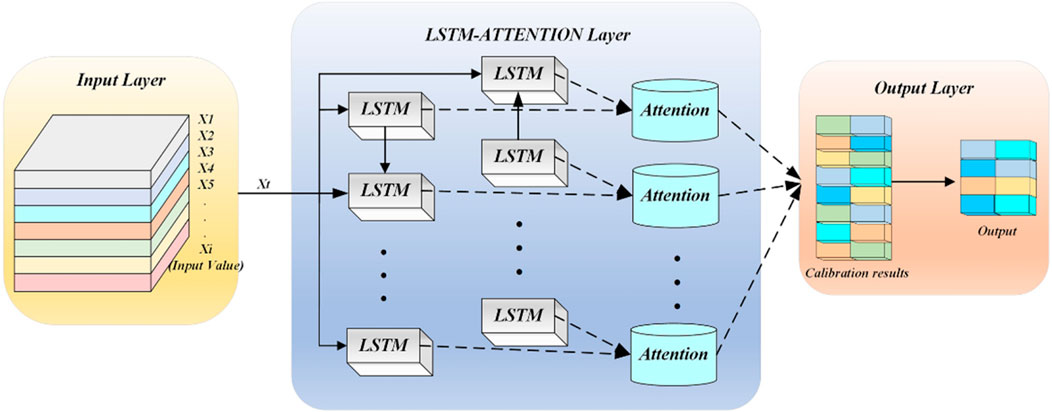
Figure 4. Structural schematic diagram of power metering device performance calibration algorithm based on Attention-LSTM.
The working principle of the attention-LSTM model is as follows.
1) An embedding layer transforms Each input sequence element into a vector representation.
2) The LSTM network processes the output of the embedding layer to generate a sequence of outputs containing all time steps.
3) The attention mechanism calculates a weight vector for each time step output, representing the importance of each element in the input sequence at the current time step.
4) The outputs of all time steps and their corresponding weight vectors are weighted and summed to generate the final representation.
5) The final representation passes through a fully connected layer to output the model’s prediction results.
3.4 Modelling evaluation
To validate the accuracy of the constructed power metering device performance correction model, the authors utilize three widely recognized error evaluation indices: Mean Absolute Percentage Error (MAPE), Root Mean Square Error (RMSE), and Mean Absolute Error (MAE) (Chen et al., 2016). These indices are calculated as follows:
where m is the sample size,
These error evaluation metrics comprehensively assess the model’s performance correcting power metering device measurements. In the results section, the authors will present the calculated values of MAPE, RMSE, and MAE to demonstrate the precision and effectiveness of our model.
3.5 Calibration error
“The Standard Electric Energy Meter" is a Chinese national standard implemented on 1 December 2011. The principle of standard metering for verifying electric energy meters involves comparing a standard meter with the meter under test. A standard meter is rigorously calibrated and has a high level of accuracy. After calibration, the influence of environmental factors on it can be disregarded, making it suitable as a reference standard for calibrating other energy meters. In order to analyze the calibration error of the power measuring device, three single-phase energy meters and two three-phase energy meters are selected as the basis for analysis. According to the verification provisions, using the standard energy meter method for verification of the measurement error of the power meter, the following formula is used to calculate the inspection power meter's verification error (Kai et al., 2021).
where
3.6 Overall flow of the algorithm
The mutual information correlation analysis first screens the environmental influence factors in the proposed power device performance correction method considering multiple link elements. The environmental factors that significantly influence the power device’s performance are extracted by setting the corresponding thresholds. Then, the power device performance correction model is constructed by combining the historical measurement data through the LSTM network. The complete algorithm process is depicted in Figure 5.
4 Result and discussion
In the current body of knowledge, research on error correction methods for electric metering devices primarily focuses on enhancing measurement accuracy and stability, often overlooking the impact of environmental factors on device performance. Especially in complex application environments, factors such as temperature, humidity, and magnetic fields directly and significantly affect the accuracy of electric metering devices. Although existing research outcomes provide specific solutions at theoretical and experimental levels, they still need more comprehensive consideration and effective correction of the integrated impact of environmental factors. This study aims to fill this knowledge gap by constructing an LSTM network model integrated with an attention mechanism. This model not only focuses on the direct correction of errors but, more importantly, is capable of intelligently identifying and addressing the impact of environmental factors on electric metering errors. The model demonstrates how to effectively enhance the correction accuracy of electric metering devices by considering vital ecological variables such as temperature, humidity, and PH values. Experimental results validate the model’s superior performance under different seasonal and various environmental conditions compared to traditional LSTM, CNN, and DNN models. This method significantly improves error reduction, model stability, and adaptability.
4.1 Introduction to the experimental platform and experimental data
The case study analysis utilizes 1 year of sampling data from an electric power metering device in a particular region of China to verify the practical feasibility of the error correction method for electric power metering devices and to validate its effectiveness. The data spans from 1 January 2018, to 31 December 2018. At the same time, an experimental platform for error calibration of power metering devices was built. The experiment uses the German ZERA power calibration device (shown in Figure 6) and the American Fluke 8508A digital multimeter (shown in Figure 7) as experimental equipment to simulate different environmental conditions in the laboratory environment and complete the corresponding experiments, to further verify the effectiveness and reliability of the error calibration method. The experimental environment consists of laboratory data collection and instrument error correction segments. The error correction model is constructed on the Python platform, and all simulation experiments are conducted on a PC equipped with 16 GB of RAM and an Intel i5-9400 processor. The specific setup of the experimental environment is illustrated in Figures 6, 7.
4.2 Selection and analysis of environmental factors based on mutual information
This section elaborates further on the selection process for multiple environmental factors based on mutual information. It details the specific computation process and analyzes the correlation of different environmental factors with their impact on electric power metering devices.
Based on the sampling data of the electric power metering device from Section 3.1, the measurement deviation index is calculated using Formula (2). The environmental factors and the measurement deviation index of the electric power metering device using Formula (3) are normalized to obtain a series of normalized data. According to Formula (1), the mutual information values between various environmental factors and the measurement deviation index of the electric power metering device are calculated. The results are presented in Table 1. A heatmap of mutual information values for various environmental factors derived from these mutual information values is shown in Figure 8.
From Table 1 and Figure 8, it is evident that environmental temperature and humidity significantly impact the measurement performance of electric power metering devices, with mutual information values of 0.924 and 0.872, respectively, corresponding to the lightest colors on the heatmap. In contrast, the influence of magnetic induction intensity on the measurement performance of electric power metering devices is minimal, with a mutual information value of 0.325, indicated by the darkest color on the heatmap. Generally, a mutual information value greater than 0.5 suggests a noticeable association between two variables. Therefore, the seven environmental variables analyzed all impact the measurement performance of electric power metering devices. However, considering that too many input features in the model could degrade the fitting effect, this paper selects 0.8 as the threshold for environmental factor selection through expert analysis and multiple simulation tests. Thus, the model training considers temperature, humidity, and PH value as ecological factors.
4.3 Model training parameter configuration
The LSTM model parameters are shown in Table 2. Three hidden levels are specified because too many layers will make the model’s convergence difficult (Abdel-Nasser and Mahmoud, 2019). This setting aims to ensure the model learns more data information while enhancing the training efficiency. The three buried layers are set to have 128, 64, and 64, respectively, with a step size of 10. The activation function used is Sigmoid, the dropout rate is 0.25, and the model will train for five epochs.
Besides the abovementioned parameters, a preventer is introduced in the LSTM model to prevent overfitting. During the LSTM training iteration process, the Drop layer randomly hides some neurons to carry out training and optimization. This approach enhances the model’s generalization ability and prevents overfitting. The LSTM model in this paper has a Dropout parameter set at 0.25.
4.4 Correction method for electric power metering device performance
This part creates a correction model for measuring the performance of electric power metering equipment using the Attention-LSTM network to study how different environmental factors affect error correction.
Typical daily data from each of the four seasons within a year are selected to correct the test set data. The dates chosen for comparison with the test dataset are March 5th, June 5th, September 5th, and December 5th, representing spring, summer, autumn, and winter, respectively. Moreover, to further validate the performance of the proposed electric power metering device performance correction method, this section also includes comparisons with the measurement data from electric power meters without performance correction and methods such as LSTM (Li et al., 2019), Convolutional Neural Networks (CNN) (Haq et al., 2023), and Deep Neural Networks (DNN) (Hossen et al., 2018). Figure 9 displays the comparing results.
Figure 9 illustrates that the performance correction techniques of all four electric power metering devices can minimize measurement inaccuracies and enhance performance. The traditional LSTM and CNN methods have the least effective correction results. As the number of measurements by the metering device increases, the method proposed in this paper demonstrates the best correction effectiveness compared to the DNN method, with the most significant reduction in error across all four seasons.
Subsequently, the analysis using the formulas for MAPE, RMSE, and MAE, as shown in Eqs 14–16, examines different error evaluation indicators for the electric power metering device under various environmental factors. The results are presented in Table 3.
The LSTM-Attention correction model has an average MAPE of 1.895, as shown in Table 3, which is a reduction of 38.21%, 26.35%, and 97.36% compared to LSTM, CNN, and DNN, respectively. The average RMSE and MAE values of the LSTM-Attention correction model are also significantly lower than other correction models, indicating that the performance correction model based on Attention-LSTM proposed in this paper has the best performance correction effects. It is attributed to introducing the Attention mechanism, which enhances the correction model’s sensitivity to multiple environmental factors and strengthens its ability to extract environmental factors’ features in different seasons. Moreover, compared to the control group without performance correction, the LSTM-Attention correction model reduced the error by more than 10%, effectively lowering the error of the electric power metering device in summer, autumn, and winter. To validate the impact of environmental factors on the performance correction model, Table 4 displays the results of the performance correction model without considering environmental factors.
Combining the results from Tables 3, 4, it is evident that fully considering the impact of environmental factors in the electric power metering device performance correction model can further improve the model’s correction level, validating the effectiveness of the proposed method.
4.5 Analysis of calibration error correction
To confirm the applicability of the proposed correction model, under the consideration of multiple environmental factors, the performance correction model for electric power metering devices based on Attention-LSTM is used to correct the electric power metering data. Subsequently, Formula (17) is applied to calculate the verification errors before and after the performance correction for single-phase and three-phase electricity meters, assuming a power factor of 1. The comparison analyzes the verification errors and the verification error correction rates before and after the correction for both single-phase and three-phase electricity meters. Figure 10 shows the comparison of verification errors for single-phase electricity meter 1, and Figure 11 shows the comparison for three-phase electricity meter 1, with specific experimental results presented in Table 5.
As shown in Figures 10, 11, with the increase in the number of tests, the correction rates of verification errors for single-phase and three-phase electricity meters are concentrated around 10%. The verification errors after correction are significantly lower than before, indicating that the verification errors have been effectively corrected. In addition, it can be observed that the verification errors of three-phase electricity meters are lower than those of single-phase electricity meters, suggesting that three-phase electricity meters have superior performance. In addition, Figures 12, 13 show the changes in the electrical energy measurements before and after calibration and their comparison with the standard measurements of electrical energy.
According to Table 5, the verification errors of three single-phase electricity meters and two three-phase electricity meters after correction are all lower than those before correction, and the correction rates of verification errors are close to 10%. It indicates that the performance correction model for electric power metering devices based on the Attention-LSTM network, which considers multiple environmental factors as proposed in this paper, can effectively correct the verification errors of electric power metering devices and reduce them by about 10%.
According to Table 5, the verification errors of three single-phase electricity meters and two three-phase electricity meters after correction are all lower than those before correction, and the correction rates of verification errors are close to 10%. It indicates that the performance correction model for electric power metering devices based on the Attention-LSTM network, which considers multiple environmental factors as proposed in this paper, can effectively correct the verification errors of electric power metering devices and reduce them by about 10%. Therefore, the performance correction model for electric metering devices based on the Attention-LSTM network demonstrates significant advantages over other machine learning methods. The long-term dependency learning capability of the LSTM network, combined with the introduction of the attention mechanism, endows the model with efficient recognition and processing capabilities for crucial information in time series data. This model can dynamically focus on the most critical parts of the data while considering the impact of environmental factors, thereby achieving a comprehensive understanding of the fluctuations in electric meter readings. The integrated application of this methodology optimizes the processing of complex electrical data. It significantly enhances the predictive accuracy of performance correction tasks, reflecting its outstanding performance in the electric metering device performance correction.
5 Conclusion
A method for correcting the performance of electric power metering devices, considering multiple environmental factors, is proposed. This method quantifies the influence of different environmental elements on the measurement deviation of electric power metering devices using mutual information correlation analysis, which reduces the input dimensions of the electric power metering device performance correction model and enhances training efficiency while ensuring the model’s fitting effect. An Attention Mechanism-LSTM network-based performance correction model for electric power metering devices is constructed, providing the LSTM network extracts critical information from the electric power measurement sequence data more effectively, thereby further improving the model’s accuracy. Compared to other methods, the constructed performance correction model exhibits a superior correction level, achieving an approximate 10% correction rate for verification errors of electric power metering devices. In the future, the impact of operational conditions of electric power metering devices on measurement accuracy will be considered to enhance the model’s engineering adaptability further.
Data availability statement
The original contributions presented in the study are included in the article/supplementary material, further inquiries can be directed to the corresponding author.
Author contributions
BZ: Conceptualization, Writing–original draft. XX: Data curation, Writing–review and editing. CH: Formal Analysis, Writing–review and editing. WK: Methodology, Writing–review and editing. JZ: Supervision, Writing–review and editing.
Funding
The author(s) declare that financial support was received for the research, authorship, and/or publication of this article. This work is supported by The Laboratory Open Fund of Beijing Smart-chip Microelectronics Technology Co., Ltd. (Grant No. SGSC0000KJQ2207189).
Acknowledgments
The authors gratefully acknowledge the support of the Laboratory Open Fund of Beijing Smart-chip Microelectronics Technology Co., Ltd. (Grant No. SGSC0000KJQ2207189).
Conflict of interest
Authors BZ, XX, CH, WK, and JZ were employed by Beijing Electric Power Science and Smart Chip Technology Company Limited and Beijing Smart-Chip Microelectronics Techno1ogy Co., Ltd.
The authors declare that this study received funding from The Laboratory Open Fund of Beijing Smart-chip Microelectronics Technology Co., Ltd. The funder had the following involvement in the study: study design, data collection and analysis, decision to publish, and preparation of the manuscript.
Publisher’s note
All claims expressed in this article are solely those of the authors and do not necessarily represent those of their affiliated organizations, or those of the publisher, the editors and the reviewers. Any product that may be evaluated in this article, or claim that may be made by its manufacturer, is not guaranteed or endorsed by the publisher.
References
Abdel-Nasser, M., and Mahmoud, K. (2019). Accurate photovoltaic power forecasting models using deep LSTM-RNN. Neural Comput. Appl. 31, 2727–2740. doi:10.1007/s00521-017-3225-z
Aslam, M., Lee, S. J., Khang, S. H., and Hong, S. (2021). Two-stage attention over LSTM with Bayesian optimization for day-ahead solar power forecasting. IEEE Access 9, 107387–107398. doi:10.1109/access.2021.3100105
Bai, J., Jiang, M., Liu, L., Sun, Y., Wang, Y., and Zhang, J. (2019). Correlation analysis and prediction of power network loss based on mutual information and artificial neural network. IOP Conf. Ser. Earth Environ. Sci. 227 (3), 032023. doi:10.1088/1755-1315/227/3/032023
Bartolomei, L., Cavaliere, D., Mingotti, A., Peretto, L., and Tinarelli, R. (2020). Testing of electrical energy meters subject to realistic distorted voltages and currents. Energies 13 (8), 2023. doi:10.3390/en13082023
Chen, Q., Kaleshi, D., Fan, Z., and Armour, S. (2016). Impact of smart metering data aggregation on distribution system state estimation. IEEE Trans. Industrial Inf. 12 (4), 1426–1437. doi:10.1109/tii.2016.2573272
Cheng, D., Zhang, P., Zhang, F., et al. (2019). Fault prediction of online power metering equipment based on hierarchical bayesian network. Inf. MIDEM 49 (2), 91–100.
Chowdhury, M. R., Tripathi, S., and De, S. (2020). Adaptive multivariate data compression in smart metering Internet of Things. IEEE Trans. Industrial Inf. 17 (2), 1287–1297. doi:10.1109/tii.2020.2981382
Gong, Y., Liu, H. Y., Yin, X., Li, X. G., Liang, Y. H., Man, J. X., et al. (2018). Research on verification platform of electric energy metering equipment operated in typical environment. IOP Conf. Ser. Mater. Sci. Eng. 439 (5), 052020. doi:10.1088/1757-899x/439/5/052020
Haq, E., Pei, C., Zhang, R., Jianjun, H., and Ahmad, F. (2023). Electricity-theft detection for smart grid security using smart meter data: a deep-CNN based approach. Energy Rep. 9, 634–643. doi:10.1016/j.egyr.2022.11.072
He, Y., Chen, L., Gao, Y., Ma, J. H., Xu, Y., and Zhu, Q. X. (2022). Novel double-layer bidirectional LSTM network with improved attention mechanism for predicting energy consumption. ISA Trans. 127, 350–360. doi:10.1016/j.isatra.2021.08.030
Hossen, T., Nair, A. S., Chinnathambi, R. A., et al. (2018). “Residential load forecasting using deep neural networks (DNN),” in 2018 North American power symposium (NAPS) (IEEE), 1–5.
Kai, X., Si, L., Jianfang, W., et al. (2021). “Comparative analysis of basic errors of high-level electric energy meter verification device,” in 2021 power system and green energy conference (PSGEC) (IEEE), 572–576.
Li, J., Xue, W., Gao, L., Zhang, B., and Zhou, M. (2018). A new method to analyze the error-wiring of electric energy metering de-vice. IOP Conf. Ser. Mater. Sci. Eng. 381 (1), 012144. doi:10.1088/1757-899x/381/1/012144
Li, X., Ma, J., Zhu, Y., et al. (2019). “Extraction of abnormal points from on-line operation data of intelligent meter based on LSTM,” in 2019 IEEE 9th annual international conference on CYBER technology in automation, control, and intelligent systems (CYBER) (IEEE), 586–591.
Liu, Z., Tan, Q., Zhou, Y., and Xu, H. (2021). Syncretic application of IBAS-BP algorithm for monitoring equipment online in power system. IEEE Access 9, 21769–21776. doi:10.1109/access.2021.3055247
Lloret, J., Tomas, J., Canovas, A., and Parra, L. (2016). An integrated IoT architecture for smart metering. IEEE Commun. Mag. 54 (12), 50–57. doi:10.1109/mcom.2016.1600647cm
Ma, J., Teng, Z., Tang, Q., Qiu, W., Yang, Y., and Duan, J. (2021). Measurement error prediction of power metering equipment using improved local outlier factor and kernel support vec-tor regression. IEEE Trans. Industrial Electron. 69 (9), 9575–9585. doi:10.1109/tie.2021.3114740
Ma, L., Meng, Z., Teng, Z., and Qiu, W. (2022). A reliability evaluation framework for smart meters based on AGG-ARIMA and PFR. Meas. Sci. Technol. 33 (4), 045006. doi:10.1088/1361-6501/ac42e6
Miao, Y., Jin, M., Tang, J., et al. (2018). “Calculation method of partial discharge severity assessment index weight using factor analysis based on mutual in-formation,” in 2018 IEEE international conference on high voltage engineering and application (ICHVE) (IEEE), 1–4.
Miraftabzadeh, S. M., and Longo, M. (2023). High-resolution PV power prediction model based on the deep learning and attention mechanism. Sustain. Energy, Grids Netw. 34, 101025. doi:10.1016/j.segan.2023.101025
Qin, J., Zhang, Y., Fan, S., Hu, X., Huang, Y., Lu, Z., et al. (2022). Multi-task short-term reactive and active load forecasting method based on attention-LSTM model. Int. J. Electr. Power and Energy Syst. 135, 107517. doi:10.1016/j.ijepes.2021.107517
Qiu, W., Tang, Q., Yao, W., Qin, Y., and Ma, J. (2020). Probability analysis for failure assessment of electric energy metering equipment under multiple extreme stresses. IEEE Trans. Industrial Inf. 17 (6), 3762–3771. doi:10.1109/tii.2020.3025314
Sherstinsky, A. (2020). Fundamentals of recurrent neural network (RNN) and long short-term memory (LSTM) network. Phys. D. Nonlinear Phenom. 404, 132306. doi:10.1016/j.physd.2019.132306
Sun, Y., Zhai, X., Dong, X., et al. (2022). “State detection of electric energy metering device using computer neural network,” in 2022 IEEE 2nd international conference on data science and computer application (ICDSCA) (IEEE), 392–395.
Verhelst, B., Rens, S., Rens, J., Knockaert, J., and Desmet, J. (2023). On the remote calibration of instrumentation transformers: influence of temperature. Energies 16 (12), 4744. doi:10.3390/en16124744
Xia, T., Liu, C., Lei, M., Xia, S., and Ming, D. (2022). Measurement error estimation for distributed smart meters through a modified BP neural network. Front. Energy Res. 10, 928681. doi:10.3389/fenrg.2022.928681
Xu, H., Li, P., Cong, Z., Pan, Y., Wu, Z., and Ren, X. (2021). Research on fault diagnosis method of electric energy metering equipment based on expert system. IOP Conf. Ser. Earth Environ. Sci. 632 (4), 042072. doi:10.1088/1755-1315/632/4/042072
Yang, X., Wang, Y., Zhang, Y., Yao, W., and Wen, J. (2022). Impact analysis of cyber system in microgrids: perspective from economy and reliability. Int. J. Electr. Power and Energy Syst. 135, 107422. doi:10.1016/j.ijepes.2021.107422
Zhan, X., Lei, L., and Kou, L. (2021). “An electric power fore-casting method based on dual time series attention mechanism neural network structure,” in 2021 IEEE 21st international conference on software quality, reliability and security companion (QRS-C) (IEEE), 918–925.
Zhang, F., Guo, J., Yuan, F., Shi, Y., Tan, B., and Yao, D. (2023a). Research on intelligent verification system of high voltage electric energy metering device based on power cloud. Electronics 12 (11), 2493. doi:10.3390/electronics12112493
Zhang, J., Cheng, Y., Du, J., et al. (2020a). “Research on abnormal diagnosis method of electric energy metering device based on BSO-BPNN,” in 2020 7th international conference on information science and control engineering (ICISCE) (IEEE), 2448–2452.
Zhang, J., Jiang, L., Zhang, H., Zhao, S., and Yong, L. (2023b). Research on electric energy measurement system based on intelligent sensor data in artificial intelligence environment. High Temp. Mater. Process. 42 (1), 20220300. doi:10.1515/htmp-2022-0300
Zhang, J., Wang, Y., Weng, Y., and Zhang, N. (2020b). Topology identification and line parameter estimation for non-PMU distribution network: a numerical method. IEEE Trans. Smart Grid 11 (5), 4440–4453. doi:10.1109/tsg.2020.2979368
Keywords: electricity metering device, multiple environmental elements, machine learning, long-term memory network, performance correction
Citation: Zhang B, Xia X, He C, Kang W and Zhang J (2024) Examining performance calibration in smart power system electricity metering based on environmental perception attention LSTM-network. Front. Energy Res. 12:1405725. doi: 10.3389/fenrg.2024.1405725
Received: 23 March 2024; Accepted: 22 April 2024;
Published: 15 May 2024.
Edited by:
Shaohua Wu, Dalian University of Technology, ChinaReviewed by:
Xu Han, University of Illinois Chicago, United StatesJing Li, Nanjing Tech University, China
Qingguo Peng, Guizhou University, China
Copyright © 2024 Zhang, Xia, He, Kang and Zhang. This is an open-access article distributed under the terms of the Creative Commons Attribution License (CC BY). The use, distribution or reproduction in other forums is permitted, provided the original author(s) and the copyright owner(s) are credited and that the original publication in this journal is cited, in accordance with accepted academic practice. No use, distribution or reproduction is permitted which does not comply with these terms.
*Correspondence: Bo Zhang, MzA4NjY4Nzc0QHFxLmNvbQ==
 Bo Zhang
Bo Zhang Xin Xia1,2
Xin Xia1,2
